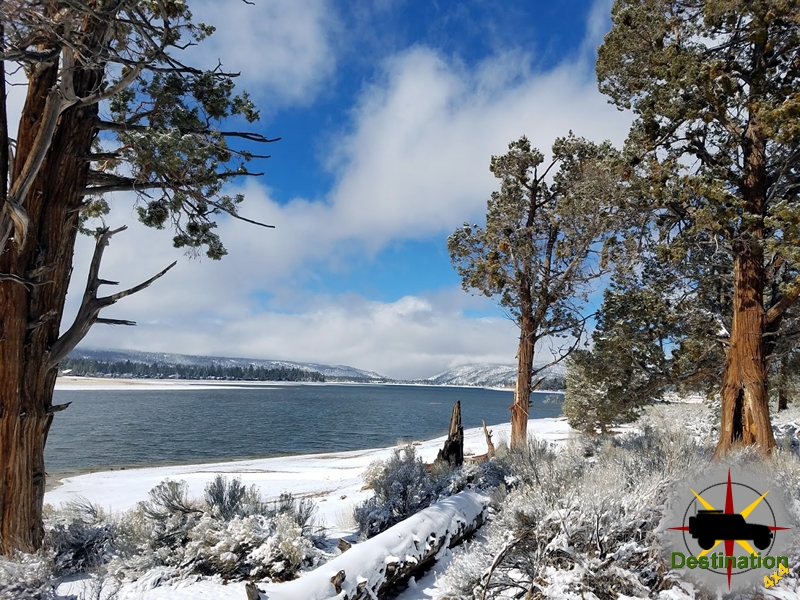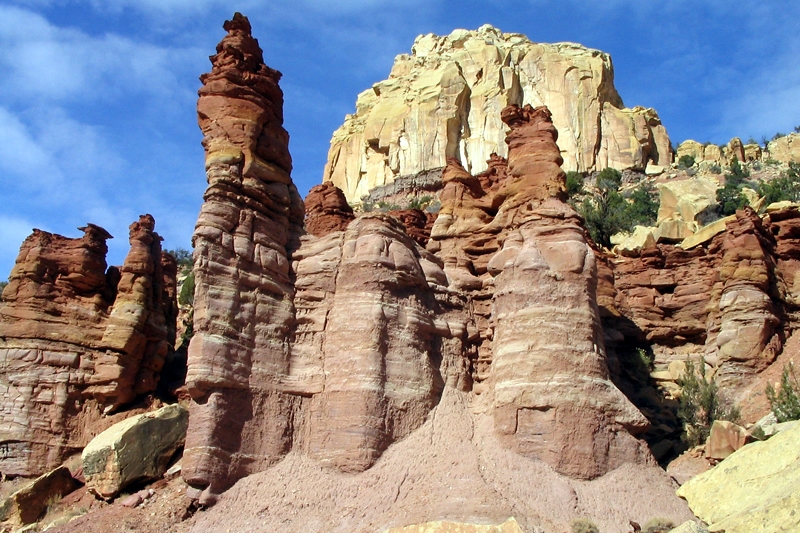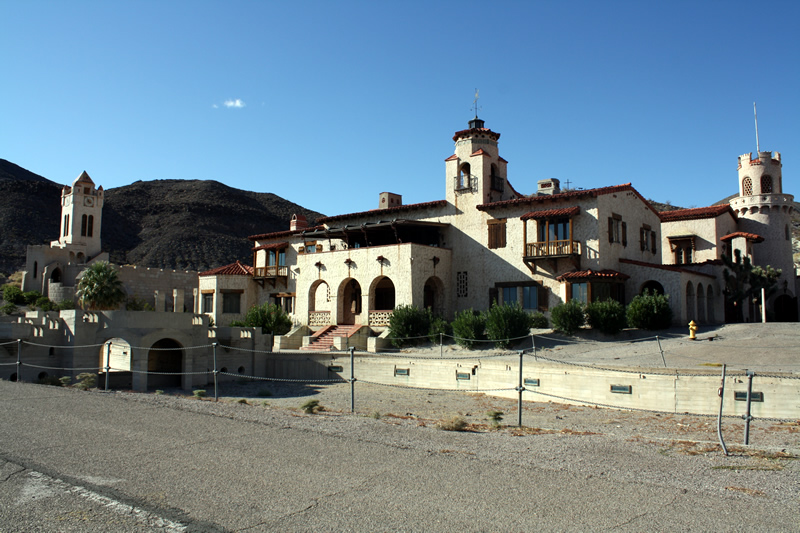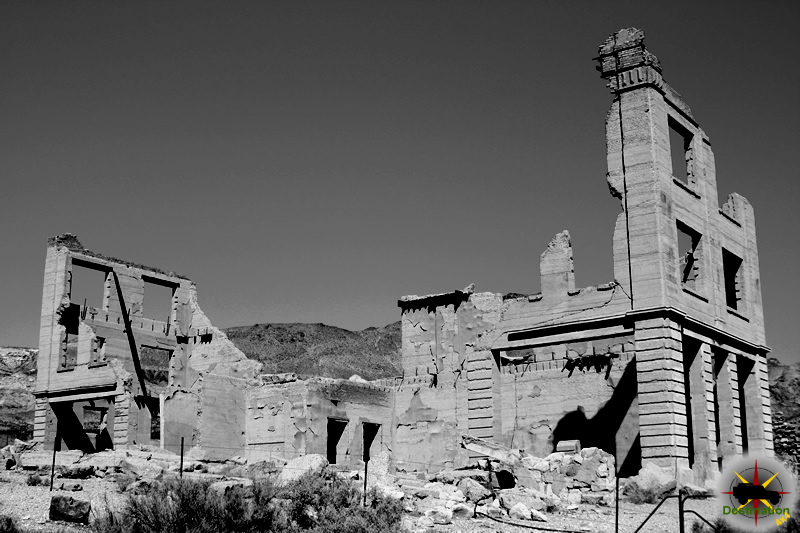
Carson City Mint – Nevada State Historic Marker
The United States Mint at Carson City, Nevada is Nevada Sate Historic Marker Number 196 and located in Carson City, Nevada.

The original Carson City building is a formal balanced, sandstone block edifice, two stories high with a centrally located, cupola. The sandstone blocks were quarried from the Nevada State prison.
On March 3, 1862, Congress passed a bill authorizing the establishment a branch of the United States mint in the Territory of Nevada. The output of the Comstock Lode Silver strike, coupled with the high bullion transportation costs to San Francisco, necessitated the action.
From its opening of the U. S. Mint in Carson City, in 1870 to the closing of the coin operations in 1893, the minted coinage amounted to $49,274,434.30. Most of the Carson City coins are scarce to rare, some of them being tremendous rarities. Others, such as the silver dollars of 1882-84, have survived in vast numbers for reasons that have nothing to do with their original mintage figures. All of these coins, whatever their rarity or market value, carry romantic associations with the Old West and the great bonanza years of the late 19th Century
Nevada State Historical Markers identify significant places of interest in Nevada’s history. The Nevada State Legislature started the program in 1967 to bring the state’s heritage to the public’s attention with on-site markers. Budget cuts to the program caused the program to become dormant in 2009. Many of the markers are lost of damaged.
Nevada State Historic Marker Text
The original Carson City building is a formal balanced, sandstone block edifice. Two stories high with a centrally located cupola. The sandstone blocks were quarried at the Nevada State Prison.
On March 3, 1862, Congress passed a bill establishing a branch mint in the Territory of Nevada.
The output of the Comstock Lode coupled with the high bullion transportation costs to San Francisco proved the necessity of a branch in Nevada.
From its opening in 1870 to the closing of the coin operations in 1893, coinage amounted to $49,274,434.30.
STATE HISTORICAL MARKER No. 196
NEVADA STATE PARK SYSTEM
NEVADA LANDMARKS SOCIETY
Nevada State Historic Marker Summary
| Name | The United States Mint at Carson City |
| Location | Carson City, Nevada |
| Nevada State Historic Marker Number | 196 |
| Latitude, Longitude | 39.1673, -119.7670 |
Nevada State Historic Marker Location
The Nevada State Historic Marker is in Carson City, Nevada. The marker is located on North Carson Street (U.S. 395), on the west side of the highway. Marker is at or near this postal address: 600 North Carson Street, Carson City NV 89701, United States of America
References
Nevada’s Capitol – Nevada State Historic Monument
Nevada’s Capitol is located in Carson City, Nevada and designated as Nevada State Historic Marker Number Twenty Five. The capitol building is located in the state capital of Carson City at 101 North Carson Street. The building was constructed in the Neoclassical Italianate style between 1869 and 1871.

The cornerstone of Nevada’s Capitol is laid on June 9, 1870. A brass box that served as a time capsule was deposited in the stone. The cornerstone was a solid block of sandstone, laid on top of blocks which contained the capsule. The Capitol Building was designed by Joseph Gosling of San Francisco. The Building was built by Peter Cavanaugh & Son of Carson City. Cavanaugh’s $84,000 bid was nearly half of the actual cost of the building. The building was constructed of locally-quarried sandstone. The silver-colored cupola dome rose 120 feet above the ground. Furnishings cost an additional $20,000.
The original building is cruciform shape in the form of a cross, with a central rectangle 76 feet wide by 85 feet deep. Each of two wings measures 35 feet wide by 52 feet in length. The window panes are made of 26-ounce French crystal. Floors and wainscotting are made of Alaskan marble which was shipped to San Francisco in 20-ton blocks. The octagonal dome topped with a cupola admits light to the second story. During 1906, an octagonal Annex was added to the rear of the capitol to house the State Library.
Nevada State Historical Markers identify significant places of interest in Nevada’s history. The Nevada State Legislature started the program in 1967 to bring the state’s heritage to the public’s attention with on-site markers. Budget cuts to the program caused the program to become dormant in 2009. Many of the markers are lost of damaged.
Nevada State Historic Marker Text
Completed in 1871, Nevada’s splendid Victorian-era Capitol was built of sandstone from the quarry of the town’s founder, Abe Curry. The octagon annex was added in 1907, the north and south wings in 1915. Notable features are its Alaskan marble walls, French crystal windows, and elegant interior.
NEVADA CENTENNIAL MARKER No. 25
STATE HISTORIC PRESERVATION OFFICE
SPONSOR: DAUGHTERS OF THE AMERICAN COLONISTS
Nevada State Historic Marker Summary
| Name | Nevada’s Capitol |
| Location | Carson City, Nevada |
| Nevada State Historic Marker Number | 25 |
| Latitude, Longitude | 39.1639, -119.7667 |
Nevada State Historic Marker Location
The Historic Marker located on the grounds of the Nevvada State Capitol. The marker is mounted on the capital building just to the right of the entrance doors. The marker is at or near this postal address: 149 South Carson Street, Carson City NV 89701, United States of America.
References
Carson City – Nevada State History Marker
Carson City Nevada State Historic Marker Number 44 is located at the State Capital of Nevada in Carson City.

Nevada State Historical Markers identify significant places of interest in Nevada’s history. The Nevada State Legislature started the program in 1967 to bring the state’s heritage to the public’s attention with on-site markers. Budget cuts to the program caused the program to become dormant in 2009. Many of the markers are lost of damaged.
Nevada State Historic Marker Text
In 1851, Frank and Warren L. Hall, George Follensbee, Joe and Frank Barnard and A.J. Rollins established one of the state’s oldest communities, Eagle Station, a trading post and ranch on the Carson Branch of the California Emigrant Trail. The station and surrounding valley took their name from an eagle skin stretched on the wall of the trading post.
In 1858, Abraham Curry purchased much of the Eagle Ranch after finding that lots in Genoa were too expensive. Together with his friends, Jon Musser, Frank Proctor and Ben Green, Curry platted a town he called Carson City. Curry left a plaza in the center of the planned community for a capitol building should a territorial state seat of government eventually be located in his town.
In March 1861, Congress created the Nevada Territory. Seven months later in November, Carson City became the capital of the territory due to the efforts of Curry and William M. Stewart, a prominent lawyer. When Nevada became a state three years later, Carson City was selected as the state capital, and by 1871, the present capitol building was completed in the plaza Curry had reserved for it.
STATE HISTORICAL MARKER No. 44
STATE HISTORIC PRESERVATION OFFICE
CARSON CITY HISTORIC COMMISSION
Nevada State Historic Marker Summary
| Name | Carson City, Nevada State Historic Marker |
| Location | Carson City, Nevada |
| Nevada State Historic Marker Number | 44 |
| Latitude, Longitude | 39.1639, -119.7670 |
Nevada State Historic Marker Location
This Nevada State Historic Marker can be reached from South Carson Street (U.S. 395/50) near East Musser Street. The marker is located on the grounds of the Nevada State Capitol Plaza on the main walkway to the Capitol building. Marker is at or near this postal address: 149 South Carson Street, Carson City NV 89701, United States of America
References
Christopher Houston Carson
Christopher Houston Carson (December 24, 1809 – May 23, 1868), also known as “Kit” Carson, was a nineteenth century American Frontiersman, Army Officer and Politician and the namesake of Carson City, Nevada. During his lifetime, he achieved notoriety for his exploits as an Indian Fighter, Fur Tapper, Mountain man

Carson was born on December 24, 1809 in Madison County, Kentucky to Lindsey Carson and Rebecca Robinson Carson. He is a cousin to Danial Boone on his mothers’ side. The family moved to Missouri two years later. Survival being the priority, Carson never learned to read or write. At the age of 16, he signed up with a large caravan of merchants headed west towards Santa Fe.
Exploration
In 1854, a change encounter with the explorer John C. Frémont, made Carson an active participant in the clash of empires that eventually extended the boundaries of the continental United States to its present. The two men met aboard a steamboat on the Missouri River. He served as a guide to for Fremont on three expeditions for a sum of $100 per month. These expeditions found the Oregon Trail and opened to west for the settlers who followed.
First expedition, 1842
In 1842, during the first expedition, Carson guided Frémont across the Oregon Trail to South Pass, Wyoming. The purpose of this expedition was to map and describe the Oregon Trail as far as South Pass. It is during this trip, that the two men produced a guidebook, maps, and other paraphernalia would be printed for westward-bound migrants and settlers. After the completion of the five-month expedition, Frémont wrote his government reports, which made Carson’s name known across the United States, and spurred a migration of settlers westward to Oregon via the Oregon Trail.
Second expedition, 1843
In 1843, Carson agreed to join Frémont’s again during his second expedition into the west. Carson guided Frémont across part of the Oregon Trail to the Columbia River in Oregon. The purpose of the expedition was to map and describe the Oregon Trail from South Pass, Wyoming, to the Columbia River. They also ventrured towards the Great Salt Lake in Utah, using a rubber raft to navigate the waters.
On the way to California, the party is held up during bad weather in the Sierra Nevada Mountains. Fortunately, Carson’s good judgement and his skills as a guide and they found some American settlers who fed them. The expedition turned towards California. This ventures is illegal, at the time, and dangerous because California was Mexican territory.
During the expedition, the expedition arrive in the Mojave Desert. His party met a Mexican man and boy, who informed Carson that Native Americans had ambushed their party. The Native Americans killed the men, and the women are staked to the ground, sexually mutilated, and killed. The murderers then stole the Mexicans’ 30 horses. Carson and a mountain man friend, Alexis Godey, went after the murderers. It took the two men, two days to find the culprits. The pair rushed into their camp and killed and scalped two of the murderers. The horses were recovered and returned to the Mexican man and boy. This act brought Carson even greater reputation and confirmed his status as a western hero in the eyes of the American people.
The Mexican government ordered Frémont to leave. Frémont returned to Washington, DC and filed his reports. He but did not mention the California trip. The government liked his reports but ignored his illegal trip into Mexico. Frémont was made a captain. The newspapers nicknamed Fremont, “The Pathfinder.”
Third expedition, 1845
In 1845, Carson lead Frémont on a third expedition. Leaving Westport Landing, Missouri, they crossed the Rockies, passed the Great Salt Lake, and down the Humboldt River to the Sierra Nevada of California and Oregon. The third expedition is more political in nature. Frémont may have been working under secret government orders. US President Polk wanted Alta California, which includes parts of California, Arizona, Nevada, Utah and parts of Wyoming.
Once in California, Frémont set out to rouse American settlers into a patriotic fervor. The Mexican General Jose Castro at Monterey ordered him to leave. On Gavilan Mountain, Frémont erected a makeshift fort and raised the American Flag in defiance to these orders. While in Oregon, while camped near Klamath Lake, a messenger from Washington, DC, caught up with Fremont and made it clear that Polk wanted California.
On 30 March 1846, while traveling north along the Sacramento Valley, Fremont’s expedition met a group of Americans Settlers. The settlers claimed that a band of Native Americans was planning to attack them. Frémont’s party set about searching for Native Americans. On April 5 1846, Frémont’s party spotted a Wintu village and launched a vicious attack, which resulted in the deaths of approximately 120 to 300 men, women, and children and the displacement of many more. This act of savagery became known as the Sacramento River massacre. Carson, later stated that “It was a perfect butchery.
Army
Kit Carson accepted a commission as a colonel in the U.S. Army in 1861, Carson fought against Native American and Confederate forces in several actions.
His fame was then at its height,… and I was very anxious to see a man who had achieved such feats of daring among the wild animals of the Rocky Mountains, and still wilder Indians of the plains…. I cannot express my surprise at beholding such a small, stoop-shouldered man, with reddish hair, freckled face, soft blue eyes, and nothing to indicate extraordinary courage or daring. He spoke but little and answered questions in monosyllables.
Northern Civil War General William Tecumseh Sherman
References
Chief Tecopa – Peacemaker of the Paiutes
Chief Tecopa – Peacemaker of the Paiutes is Nevada State Historic Marker number 171 and located in Nye County, Nevada. The monument is located at his graveside in Chef Tecopa Cemetery in Pahrump, Nye County, Nevada. Tecopa (c. 1815–1904) was a Native American leased of the Southern Nevada tribe of the Paiute of the Ash Meadows and Pahrump areas.

Tecopa, who’s name means wildcat, along with several other warriors joined Kit Carson and John C. Fremont in the battle of Resting Springs which lasted for three days.
Tecopa maintained peaceful relations with the white settlers to the region and was known as a peacemaker. He often wore a bright red band suit with gold braid and a silk top hat. These clothes are replaced by local white miners when the clothes wore out. This gesture is in gratitude for Tecopa’s help in maintaining peaceful relations with the Paiute.
Tecopa is buried with his son and grandson at the Chief Tecopa Cemetery in the Pahrump Valley, Nevada.
Nevada State Historic Marker Text
Chief Tecopa – Peacemaker of the Paiutes
Chief Tecopa was a young man when the first European Americans came to Southern Nevada. As a leader among the Southern Paiutes, he fought with vigor to save their land and maintain a traditional way of life. He soon realized if his people were to survive and prosper, he would have to establish peace and live in harmony with the foreigners.
During his life, which spanned almost the entire nineteenth century, his time and energy were devoted to the betterment of his people until his death here in Pahrump Valley.
Chief Tecopa is honored for the peaceful relations he maintained between the Southern Paiutes and the settlers who came to live among them.
STATE HISTORICAL MARKER NO. 171
STATE HISTORIC PRESERVATION OFFICE
CALIFORNIA & NEVADA DEVELOPMENTORGANIZATION
Nevada State Historic Marker Summary
| Name | Chief Tecopa – Peacemaker of the Paiutes |
| Location | Pahrump, Nye County, Nevada |
| Nevada State Historic Marker | 171 |
| Latitude, Longitude | 36.2091, -115.9895 |



